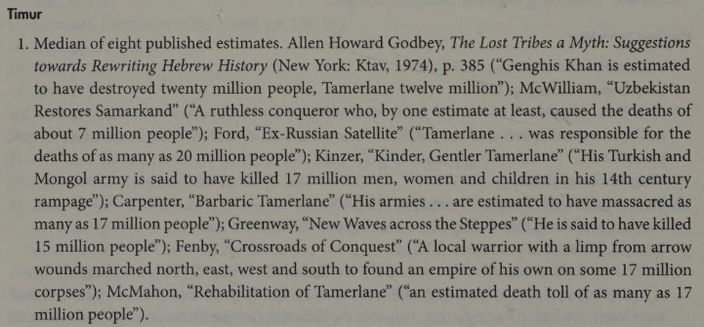The Triumph and the Tragedy of Atrocitology
To be honest, though, I’m sometimes embarrassed by where I have been forced to find my statistics, but beggars can’t be choosers. Very few historians have the cold, calculating, body-count mentality that I do. They prefer describing the quality of suffering rather than the quantity of it. Often, the only place to find numbers is in a newspaper article, almanac, chronicle or encyclopedia which needs to summarize major events into a few short sentences or into one scary number, and occasionally I get the feeling that some writers use numbers as pure rhetorical flourishes. To them, “over a million” does not mean “>106“; it’s just synonymous with “a lot”.
Matthew White, http://necrometrics.com/warstats.htm#Recurring
Matthew White’s Great Big Book of Horrible Things (W.W. Norton and Company, 2011) lists 100 tragedies, but the 101st tragedy is the book itself. White worked very hard to find numbers for various atrocities, and noticed that often he could find no source for the number in the glossy magazine or the airport book. He noticed that some of the numbers seemed to be just made up, he noticed that some didn’t seem to be meant to be taken literally, and he noticed that often the new book or article relies on the old book or article without correcting its mistakes or asking whether we have learned anything since. When I look at the website which became the book, I see how he came close to agreeing with me that almost all of these numbers before the 19th century say more about other modern numbers than about the past. He could have written a good book about how we just don’t know how many people were killed by Tamurlane, or the An Lushan Rebellion, or the Crusades. But instead he wrote yet another book full of made-up numbers backed with footnotes, and he gave old nonsense a whole new audience when a very famous Canadian psychologist took his numbers and ran with them.
One of his ten greatest atrocities was the wars of Tamurlane. His sources for this were seven newspaper articles about Uzbekistan (!), a book on the Lost Tribes of Israel by an eccentric clergyman who died in 1948, and a universal history published in 1906. None of these sources said how they knew how many Tamurlane had killed or who had told them how many Tamurlane killed. I look at those facts and say “no book or article in English has evidence for how many people Tamurlane killed.” Matthew White looked at those same facts and decided that these wars were one of the ten greatest atrocities in history because the made-up numbers in those books and newspaper articles were really big! Two of his ten greatest atrocities, and twelve of his thirty greatest, are events before the 19th century where there are no good sources for numbers (and I’m not sure that the sources for the Mahdist kingdom in the Sudan are any better, although the British who conquered the kingdom swore that it had been a nightmare of tyranny).
Pages 146 and 580 of
The Great Big Book of Horrible Things : the Definitive Chronicle of History’s 100 Worst Atrocities (paperback 2012) give the same total as the Atrocitology website but takes the median of eight sources rather than nine. In the book, White excluded the translation of a universal history from 1906, but included the book by the eccentric clergyman (Godbey) and seven newspaper articles.
If Matthew White had just been a little braver or a little more experienced, he could have acted like a wise judge and thrown most of these numbers out. But instead he acted like a bad lawyer and decided that everyone is a self-interested and just makes an argument to support a pre-existing position. But no court on earth would say that because the prosecutor says “he did it!” and the accused says “no I did not!” no truth can be found. He worked so hard to dig the sources for these numbers out of their dusty crypts, but because he was not critical, he returned from his dig with a strange look in his eye saying that he found no nonsense whatsoever just harmless facts and anyone saying there were zombie ideas down there was peddling rubbish and that new bandage is just from cutting himself on a broken tile.
I wonder what would have happened if someone had walked him through how when you ask people “how many break-ins or thefts were there in your neighbourhood last year?” the ones who report false high numbers can drown out the ones who report false low numbers. You can’t report less than 0, but you can report as many as you can imagine. And some people’s imaginations are bigger than mine.
Further Reading
Ray Fisman, Andrew Gelman, and Matthew C. Stephenson, “The Statistics That Come Out of Nowhere,” The Atlantic, 12 March 2023 https://www.theatlantic.com/ideas/archive/2023/03/bad-misleading-statistics-false-information-estimates/673359/
Dinei Florêncio and Cormac Herley, “Sex, Lies and Cyber-crime Surveys,” presentation at WEIS 2011 https://www.microsoft.com/en-us/research/publication/sex-lies-and-cyber-crime-surveys/ Counts of centenarians are also easy to distort due to people exaggerating their age in places with poor records or hiding the death of relatives to keep their pensions.
The well-respected Our World in Data only tries to give numbers two pandemics before 1817: the Black Death (very thoroughly studied, in a part of the world which left some archives and a lot of archaeology) and the Columbian Pandemics in the Americas (very controversial because experts can’t agree on the population of the Americas in 1491 within a factor of ten) https://ourworldindata.org/historical-pandemics
Edit 2024-02-17: added photo of the printed version of Atrocitology to show that it had no new sources to show that Timur’s wars were the ninth most lethal conflict in history
Edit 2024-02-24: see also Wikipedia s.v. Paraguayan War Casualties (on the war between Paraguay and the Triple Alliance of Argentina, Brazil, and Uruguay in 1864-1870)
The number of people who died in the Paraguayan War (1864–1870) is unknown. Widely diverging estimates have been made. … No academic demographic scholarship makes it less than 7% (including migration) or greater than 69%. … The traditional view was challenged even more strongly by historian Vera Blinn Reber in 1988 in ‘The Demographics of Paraguay: A Reinterpretation of the Great War, 1865–1870’ … She noted that, hitherto, mortality estimates had depended on comparing various censuses of the Paraguayan population before and after the war. However, she claimed that the census data that had been used were not reliable.
(scheduled 1 October 2023)
#historicalDatasets #medieval #modern #nonsense #Tamurlane











